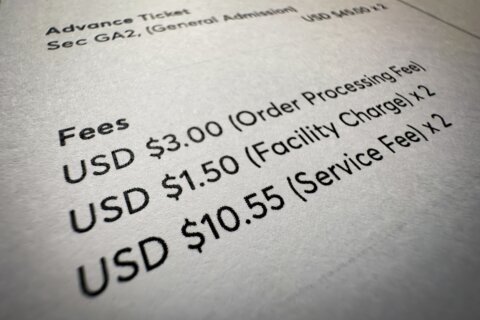This article was republished with permission from WTOP’s news partners at Maryland Matters. Sign up for Maryland Matters’ free email subscription today.
This content was republished with permission from WTOP’s news partners at Maryland Matters. Sign up for Maryland Matters’ free email subscription today.
While the COVID-19 pandemic has posed its fair share of challenges, it’s also opened the eyes of tens of thousands of uninsured Marylanders, many of whom rushed to enroll in health care plans ahead of falling ill.
Prior to the COVD-19 pandemic, about 6% of Maryland residents were uninsured ― better than the federal uninsured rate, but almost twice the rate of Massachusetts, which holds the U.S.’s lowest rate of 3%.
It’s been estimated that about half of those 357,000 Marylanders without health insurance are eligible to enroll through private subsidized plans, Medicare, Medicaid or a combination of the three.
“Still room for improvement,” Johanna Fabian-Marks, director of policy and plan management for the Maryland Health Benefit Exchange, told the House Health and Government Operations Insurance and Pharmaceuticals Subcommittee on Tuesday afternoon. “And the easy enrollment program is one avenue to continue making progress in reducing that insurance rate and making sure people are aware of their options for coverage, making it easier for them to enroll.”
Since the Maryland Health Benefits Exchange has been active, several programs have been deployed to further decrease the number of uninsured Marylanders, including the state’s easy enrollment plan, which gives people the ability to apply to enroll in a healthcare plan when they fill out their tax return.
“Easy enrollment is a really exciting way to reach these folks who are eligible for coverage and may not realize that or may not have taken action to enroll,” said Fabian-Marks.
This year was the first time that the “check the box” plan was in effect. And 53,146 of the nearly 61,000 people to check the box confirming their status as an uninsured individual were deemed eligible to register. About 17% applied and just 8% ended up enrolling, which Fabian-Marks called “really remarkable.”
“We’d like to see that higher, of course ― that’s a big drop off from 53,000 to 4,000 ― but for … just checking a box and then we sent them a letter, I think that’s quite a successful conversion rate,” she said.
But there are other programs that have eased the pain of seeking out and paying for health insurance, too.
The Maryland Health Benefit Exchange’s reinsurance program slashes the cost of health insurance premiums in the individual market by covering portions of insurers’ claims. In turn, these lower premiums mean that the federal government pays less to subsidize insurance for people earning up to 400% of the federal poverty level.
The federal government then passes the money it saved on to the state health benefits exchange to fund Maryland’s reinsurance program.
According to Fabian-Marks, individual market premiums will be down nearly 12% and lower than the national average by 20% to 30% in 2021.
“Individual markets premiums have continued to fall,” said Fabian-Marks. “We’ve really seen great success in the reinsurance program.”
And as premiums have gone down, the number of people enrolled through the reinsurance program has been on the rise. At the end of the 2020 open-enrollment period, enrollment saw a four-year high.
“What we’re seeing this year, largely [and] unfortunately due to the impact of COVID, has been enrollment has really been surging over the course of the year,” Fabian-Marks explained to the sub-committee.
Because of COVID-19, the state’s open enrollment period and the deadline to file taxes were extended, allowing more eligible individuals to “check the box” or apply through the reinsurance program.
During the special enrollment period, which began in March and lasts through Dec. 15, Fabian-Marks said that over 93,000 people have signed up for health insurance coverage.
‘A very, very good’ vetoed bill
Maryland’s Prescription Drug Affordability Board is wrapping up its first ― and very challenging ― year of operations.
“The [Prescription Drug Affordability Board] currently exists, but we didn’t have any operating funds,” said Van Mitchell, the chair of the board.
During the truncated 2020 legislative session, a bill sponsored by House Speaker Adrienne A. Jones (D-Baltimore County) was put forth that would have provided the board with a funding formula outside of the state budget.
“We felt like we had a very, very good bill,” Mitchell said to the subcommittee.
Jones’ legislation passed in both the House and the Senate but was vetoed when it reached the governor’s desk.
This led Mitchell to negotiate with the Governor’s Office for permission to seek funding through the Maryland Healthcare Commission or the Health Services Cost Review Commission until the board could get a funding formula bill passed.
According to Mitchell, the board ended up having just $12,000 in expenditures this year, paid for by the Healthcare Commission. He said that projected spending for 2021 will “hopefully” include staffing, contracting with analytical firms and office space.
The Board is hoping to have $750,000 allotted in the next fiscal year to conduct its operations.
“I don’t think we’ll spend the $750,000 in the current year, but we’ll certainly spend more than $12,000,” said Mitchell.
The board’s projected five-year budget includes expenditures of just short of $1 million each year.
COVID-19, the state’s hiring freeze and the lack of a funding stream have slowed down the board’s work, but they have managed to hire one contract worker and an executive director with permission from the Department of Budget Management.
They are now working with the Department of Health, the Maryland Healthcare Commission and the Department of Budget Management to finalize the hiring process.
“As soon as we know something from those three agencies and [get] a total sign off, we’ll [be] more than happy to send you a notice and announce who the executive director will be,” Mitchell told the subcommittee.







